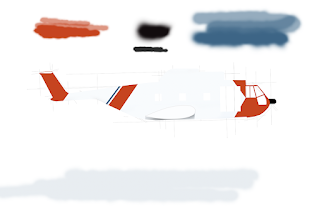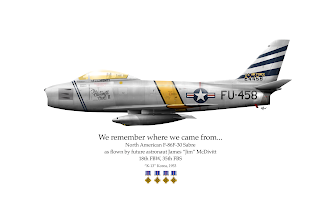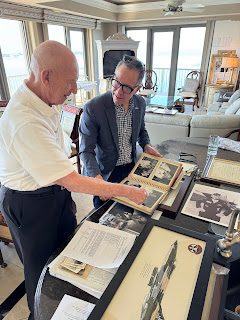The picture above contains the HH-3F helicopters as flown by USCG aviators Jimmy Ng and Patricia “PattyMac” McFetridge.
Of course, there’s a story behind the signatures - I’ll get to that in a paragraph or two.
Both helicopters carry extraordinary history. The one above and to the rear is #1471. The one in front is #1467.
So, have you read a military citation? If not, please do the memory of 1471 a favor (if inanimate objects are truly worthy of such a thing) and read the Distinguished Flying Cross citation involving 1471 and pilot Jimmy Ng.
***
CITATION
The President of the United States of America takes pleasure in presenting the Distinguished Flying Cross to Lieutenant Jimmy Ng, United States Coast Guard, for extraordinary achievement while participating in aerial flight on the evening of 17 August 1980.
During this period he was serving as pilot and aircraft commander of Coast Guard HH-3F 1471 engaged in the rescue of 17 seamen from the merchant vessel Theresa Lee which was filling with deadly ammonia gas, disabled, and sinking in Bristol Bay, Alaska.
Dispatched from Coast Guard Air Station, Kodiak, Alaska, Lieutenant Ng flew the aircraft through the remnant of one of the worst typhoons of the season to the scene. Upon arrival and despite darkness, poor visibility and turbulence in rain showers, Lieutenant Ng maneuvered the helicopter to a position over the violently pitching vessel as two dewatering pumps were lowered to the survivors. These pumps eventually saved the ship from sinking. Lieutenant Ng was now into his third launch of the day having accumulated 4.3 hours of flight time and eight hours of crew mission time on another SAR case. Facing fatigue and wind gusts of 65 knots and 40 foot seas combined with minimal visual references in the rain, Lieutenant Ng maintained his position above Theresa Lee until the 17 seamen had been hoisted to safety.
With the fuel now a critical factor, Lieutenant Ng proceeded to the closest landing area, Port Heidon, Alaska. While en route, the cockpit filled with dense smoke accompanied by the acrid odor of an electrical fire. Reacting immediately, Lieutenant Ng directed the performance of the appropriate emergency procedures which successfully resulted in the elimination of the problem. The helicopter was then safely landed at Port Heidon. Lieutenant Ng’s innovative actions, expert aeronautical skill and valor throughout this mission were instrumental in the successful rescue of the 17 seamen.
His courage, sound judgment and unwavering devotion to duty are most heartily commended and are in keeping with the highest traditions of the United States Coast Guard.
***
If you're like me, you were at once stunned by audacity of the moment and perfunctory explanation of the act. It all seems so clinical...and gobsmackingly impossible at the same time.
When talking with Jimmy about this particular event, he was (as I perceived) unconsciously dismissive, reminding me any number of times that, he'd "... lost (four) good friends on 1471." Indeed, just under a year later, on 7 August, 1981, 1471 would be wrecked during another rescue. Have a read about it here.
It was as if anything to do with his amazing action was simply insignificant to the later loss. That is a point that I'm still sorting out, but it struck me as painfully awkward. As Jimmy was awarded two DFCs for his service, I offered that I could draw the other, (1469). "No...no. You can do 1471. But just know, "...lost friends on it."
Hold that thought.
The second HH-3F, 1467, was flown by Patricia McFetridge, another DFC recipient. You should read her Distinguished Flying Cross citation:
***
CITATION:
The President of the United States takes great pleasure in presenting the Distinguished Flying Cross to Ensign Patricia A. McFetridge for extraordinary achievement while participating in aerial flight on the morning of 22 September 1990 while serving as Co-Pilot of Coast Guard helicopter HH-3F CGNR 1467.
The aircrew was dispatched to search for the fishing vessel JANICE N which was reported to have caught fire. Ensign McFetridge flew at an altitude of 100 feet through heavy rain, 75-knot wind gusts, severe turbulence, 30-foot seas, and visibility less than one-quarter mile. After an exhaustive two and one-half hour search, until fuel ran low, with visibility reduced to one-eighth mile, the aircrew sighted a raft with three persons onboard.
As the survivors were hoisted, Ensign McFetridge carefully monitored the seas, and her quick reaction on several occasions kept the aircraft from striking the water. Demonstrating great composure under pressure, during the hoists, Ensign McFetridge provided communications between the Pilot and crew when the intercom system was disabled by the driving rain.
Relieving the exhausted Aircraft Commander, she skillfully flew the aircraft, while making arrangements for medical assistance for the survivors. Ensign McFetridge's actions, aeronautical skill, and valor were instrumental in the rescue of three victims.
Her courage, judgment and devotion to duty are most heartily commended and are in keeping with the highest traditions of the United States Coast Guard.
***
Having read many DFC citations, the ones awarded to Coast Guard aircrew have a timbre of their own as they're almost always awarded for "humanitarian" reasons as opposed to those awarded for service during times of combat. I am not stating that one category is better/more than the other. It's just that they're different — that people can show the greatest of human courage & sacrifice in times of war and peace says everything about the sheer value of the word, "Character." Indeed, the measure of our life is not in years, but actions.
"PattyMac," as she is called by friends, was the first woman Coast Guard officer awarded the DFC. Having worked with her on a number of service-related projects, I'd needled her periodically about letting me interview-her properly, and all the while, she'd defer the intention with the idea that somehow, the combat veterans from the wars preceding her peace-time action needed to have their stories told before hers. This was not a polite deferment, btw. I distinctly recall her explaining with a laugh, "It was (one of) my first real mission! I didn't know any better! I just did it!"
An accidental act of bravery? Hardly. Again, reading these citations always has a common thread of extraordinary preparation, practiced skill, and a disciplined sense of Character (capitalization, mine).
The Smithsonian Institution interviewed Patty in 2019. I was able to find a complete transcription of that interview a while ago and took the time to read it. There's no way her DFC was a result of some "right place, wrong time" event (as she joked). PattyMac was made for such moments. Proof here.
Ok. So about the artwork and the signatures.
Drawing airplanes is not that hard. In fact, I figure in another year or so, AI will be doing a great job of it and, in terms of effort, the human-act of drawing/painting/rendering will be a pure vanity. If one is looking for a perfect illustration of a machine, it only makes sense that the machines themselves take care of each other.
But one thing AI will never be able to do is to take on flesh, blood, grasp a pen/brush/pencil/digital tool and scrawl the thing that identifies each of us - a name.
Indeed, it's the names and physical signatures that really bring life to (my) artwork. At once, the signature brings historic value to the ink on paper. Most importantly though, the signature says, "I, a human, made this moment. The machine was only a tool."
So, after presenting the art to Jimmy and PattyMac at the September 2025 Reunion of the Distinguished Flying Cross Society, the audience was invited to come up and sign the artwork, in addition to Jimmy and PattyMac, and of course, my quirky initials.
I haven't counted the signatures - the picture at the top of the page was taken about 75% through the signing event. But every signature represents a personal connection to the medal, the greater history, the relationships... and therefore, the humanity of it all.
May each of us write our lives realizing that our actions are being recorded, and live in enough of a community that we can all share in the glory of the best ones.
 |
Left to right (right of picture) Joy and Jimmy Ng, Patricia McFetridge, John Whiddon (2x DFC recipient, DFC Society Chairman and USCG pilot). And I am holding the microphone.
Photo courtesy Byron Derringer. |
PS - About John Whiddon (in photo above). He was awarded the first of his DFCs in 1469, the HH-3F that Jimmy Ng deferred. In honor of John's leadership of the DFCS, the citation involving 1469 is below.
CITATION
The Distinguished Flying Cross for extraordinary achievement while participating in aerial flight on the afternoon of 4 October 1980 while serving as pilot and aircraft commander of Coast Guard HH-3F 1469 engaged in the rescue of 20 survivors from the stricken passenger liner M/V Prinsendam which had caught fire 120 miles south of Yakutat in the Gulf of Alaska. The fire had forced the passengers and crew of Prinsendam into lifeboats in the dark hours of early morning.
Dispatched from Coast Guard Air Station Kodiak, Lieutenant Whiddon flew the helicopter to the scene and located a lifeboat being tossed by 25 foot cresting seas. Despite 35 knot winds and visibility often down to one-half mile, Lieutenant Whiddon skillfully guided the aircraft over the stern of the pitching and tossing boat and maintained the position as the rescue basket was lowered.
During one of the hoists the cable became tangled in the rudder of the boat. With excellent crew coordination and precision flying Lieutenant Whiddon maneuvered the helicopter to a position where the cable was freed without shearing. The hoist operations were then completed and the survivors were transported to safety on the T/V Williamsburgh and to Yakutat.
Lieutenant Whiddon's innovative actions, expert aeronautical skill and valor were instrumental in the rescue of 20 victims. His courage, sound judgment and unwavering devotion to duty are most heartily commended and are in keeping with the highest traditions of the United States Coast Guard.







































.jpg)


















